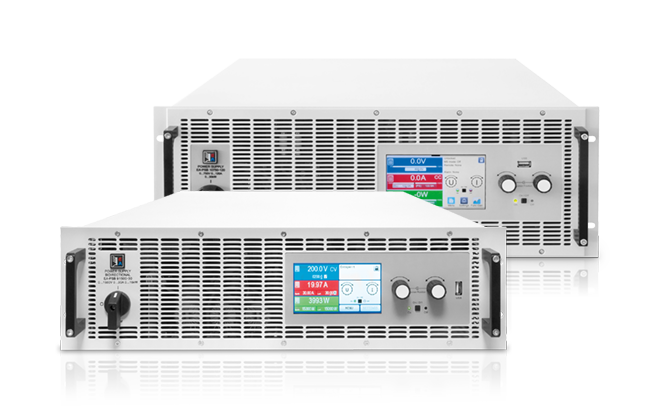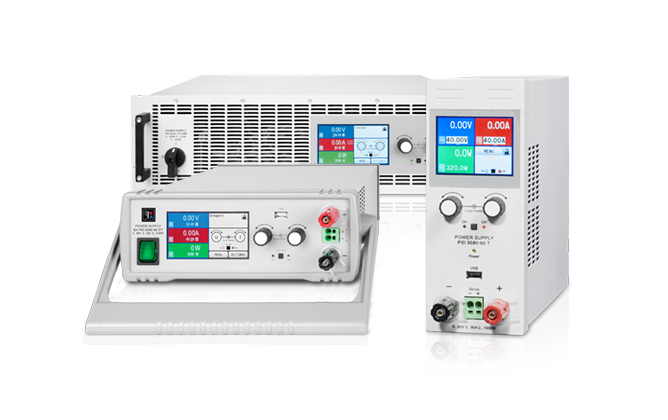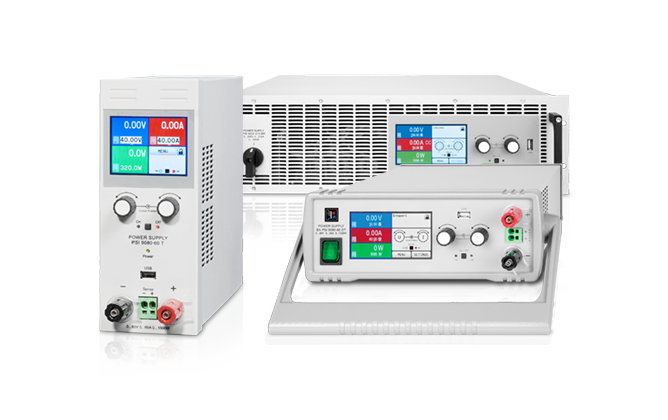Our solutions
For more efficient inspection and testing
To be competitive, it is crucial to automate test processes. Not only can automatic testing be done faster than manual testing, automatic tests are generally more effective and comprehensive than manual testing. One reason for this is that automatic testing eliminates the possibility of operator error. Tests are run the same way every time and test data gathered electronically is available for immediate analysis. Power sources and electronic loads are important components of any automatic test equipment (ATE) system. They need to be accurate, reliable, and easy to integrate into your ATE system.
EA Elektro-Automatik’s line of DC power supplies, electronic loads and bidirectional power supplies have features that help automate test processes and perform more effective tests. EA’s PSI, EL, ELR and PSB product series can provide up to 2000V, have autoranging and on-board arbitrary waveform and function generation. This flexibility allows EA to produce or sink power needed to simulate real world conditions and ensure that automatic test systems operate reliably and efficiently.
Products Used in Test Automation
Application Solutions
Autoranging Supplies are more Flexible than Traditional Supplies for Automatic Test
Programmable DC power sources are an essential tool in product development testing and production testing of a wide range of electronic devices and systems. For example, functional testing often requires submitting the device-under-test (DUT) to a wide range of operating voltages, and in some cases, the DUT will draw constant power under variable input conditions.
Common examples are DC motor drives and regulated DC/DC supplies. In such circumstances, the ability of the programmable DC source to provide increased current at reduced output voltage is valuable. This ability is known as “autoranging”. DC supplies without autoranging often requires users to oversize or use multiple supplies to test the DUT under varying input voltage conditions.
EA Advantages:
- Output voltage up to 2000V+
- Power output up to 30 kW
- High power Density
- Digital control
- Low EMC
- Industry experience
Regenerative Loads Reduce Test Costs
Switch-mode power supplies used in data centers, industrial equipment, medical devices and other critical applications are typically subjected to burn-in operation at full load over an extended period to root out early failures and ensure reliable operation over the supply’s rated lifetime. The traditional method of conducting these tests utilizes relatively inexpensive resistive load banks which convert the power output to heat. Consequently, the energy costs of conducting the burn-in far exceed the power output of the power supplies under test.
Using regenerative electronic loads (ELRs), however, dramatically reduces energy costs by up to 93% by redirecting the load power back to the utility. Other benefits of dissipating
Autoranging power supplies are more flexible than traditional power supplies and can provide increased current at reduced output voltages. This capability is valuable when testing DC motor drives and regulated DC / DC supplies less heat include smaller cooling fans, which dramatically reduces the audible noise and higher power density compared to typical air-cooled loads, which results in 2-3 times less rack space or bench space.
EA Advantages:
- Power dissipation up to 120 kW
- High power density
- Regenerative load technology
- Digital control interface
- Low EMC
- Industry experience
An Interface for Every Application or Topology
Every automatic test application has its own challenges. That is why it’s important to have a wide variety of digital interface options. For example, when testing a large system, like an aircraft, a test system may be located quite a long distance from the control computer. For this application, you may want to outfit your power supply or electronic load with an Ethernet interface.
For a production application, interfacing with a programmable logic controller (PLC) may be important. For this application, you may want a Profibus or Profinet IO interface. In some cases, you may be upgrading a legacy ATE system. For these applications, you may want an RS-232 or GPIB interface. Whatever your ATE needs, EA can supply the right remote control interface.
EA Advantages:
- Industrial grade applications: CAN, CANopen, Profibus/Profinet IO
- High data speed applications: CAN, CANopen, Ethernet, ModBus TCP, Profibus/Profinet IO
- Long distance applications: Ethernet, , ModBus TCP
- Lab applications: USB
- SCPI support: Ethernet, ModBus TCP, RS232, GPIB
- Legacy applications: RS232, GPIB
Bidirectional Power Supply Repeatably Tests Battery-powered Equipment
Testing battery-powered equipment can be tricky because battery performance varies from unit to unit, once they are discharged, you have to suspend testing until they’ve been charged again. You can, however, use EA’s bidirectional power supplies, such as the EA PSB-10000 to simulate a charging or discharging battery during an automated test. This allows testing under various battery conditions without having to wait for a battery to charge or discharge to a specific state-of-charge. In addition, we provide battery simulation software for Windows PCs, the EA Battery Simulator.
This software can control one or more EA-PSB 10000 power supplies to simulate standard lead-acid (AGM) and lithium-ion batteries in series or parallel connection for a wide variety of battery related tests. The user can adjust battery parameters for a test, and once a test has started, it runs automatically. The combination of a bidirectional power supply and this software eliminates the need for maintaining a bank of batteries for testing, while at the same time providing a wide range of test voltages and charging/discharging currents that are reliable and repeatable.
EA Advantages:
- Bidirectional
- High Power Density
- Battery simulation
- Arbitrary waveform and function generator
- Voltage models up to 2000V
- Low EMC
- Industry experience
- Plug and play paralleling up to 2MW



